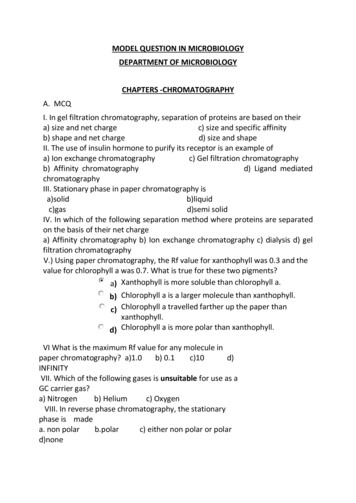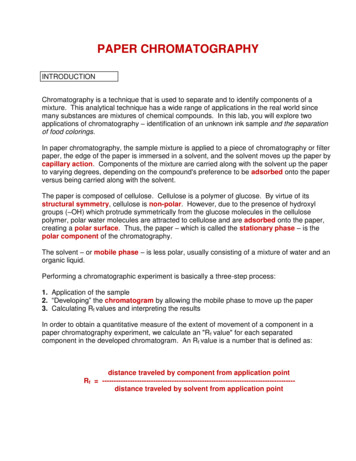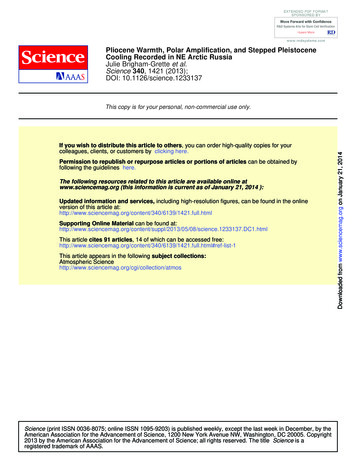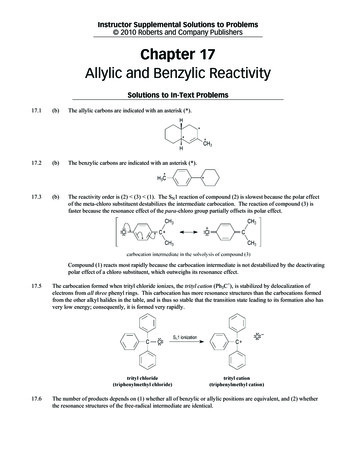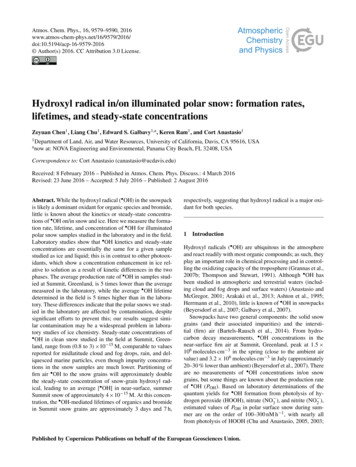
Transcription
11.4 Polar Coordinates11.4917Polar CoordinatesIn Section 1.1, we introduced the Cartesian coordinates of a point in the plane as a means ofassigning ordered pairs of numbers to points in the plane. We defined the Cartesian coordinateplane using two number lines – one horizontal and one vertical – which intersect at right angles at apoint we called the ‘origin’. To plot a point, say P ( 3, 4), we start at the origin, travel horizontallyto the left 3 units, then up 4 units. Alternatively, we could start at the origin, travel up 4 units,then to the left 3 units and arrive at the same location. For the most part, the ‘motions’ of theCartesian system (over and up) describe a rectangle, and most points can be thought of as thecorner diagonally across the rectangle from the origin.1 For this reason, the Cartesian coordinatesof a point are often called ‘rectangular’ coordinates. In this section, we introduce a new system forassigning coordinates to points in the plane – polar coordinates. We start with an origin point,called the pole, and a ray called the polar axis. We then locate a point P using two coordinates,(r, θ), where r represents a directed distance from the pole2 and θ is a measure of rotation fromthe polar axis. Roughly speaking, the polar coordinates (r, θ) of a point measure ‘how far out’ thepoint is from the pole (that’s r), and ‘how far to rotate’ from the polar axis, (that’s θ).yP (r, θ)P ( 3, 4)32θr1 4 3 2 1 11234xrPolePolar Axis 2 3 4 For example, if we wished to plot the point P with polar coordinates 4, 5π6 , we’d start at the pole,move out along the polar axis 4 units, then rotate 5πradianscounter-clockwise.6 P 4,θ 5π6 5π6r 4PolePolePole We may also visualize this process by thinking of the rotation first.3 To plot P 4, 5πthis way,65πwe rotate 6 counter-clockwise from the polar axis, then move outwards from the pole 4 units.1Excluding, of course, the points in which one or both coordinates are 0.We will explain more about this momentarily.3As with anything in Mathematics, the more ways you have to look at something, the better. The authorsencourage the reader to take time to think about both approaches to plotting points given in polar coordinates.2
918Applications of TrigonometryEssentially we are locating a point on the terminal side of5π6which is 4 units away from the pole. P 4,θ 5π6θ Pole5π6 5π6PolePoleIf r 0, we begin by moving in the opposite direction on the polar axis from the pole. For example,to plot Q 3.5, π4 we haver 3.5Poleθ π4PolePole Q 3.5,π4 If we interpret the angle first, we rotate π4 radians, then move back through the pole 3.5 units.πHere we are locating a point 3.5 units away from the pole on the terminal side of 5π4 , not 4 .θ π4Poleθ π4PolePole Q 3.5,π4 As you may have guessed, θ 0 means the rotationaway from the polar axis is clockwise instead 3πof counter-clockwise. Hence, to plot R 3.5, 4 we have the following.r 3.5PolePolePoleθ 3π4 R 3.5, 3π4From an ‘angles first’ approach, we rotate 3π4 then move out 3.5 units from the pole. We see thatR is the point on the terminal side of θ 3π4 which is 3.5 units from the pole.PolePoleθ 3π4θ 3π4Pole R 3.5, 3π4
11.4 Polar Coordinates919The points Q and R above are, in fact, the same point despite the fact that their polar coordinaterepresentations are different. Unlike Cartesian coordinates where (a, b) and (c, d) represent thesame point if and only if a c and b d, a point can be represented by infinitely many polarcoordinate pairs. We explore this notion more in the following example.Example 11.4.1. For each point in polar coordinates given below plot the point and then givetwo additional expressions for the point, one of which has r 0 and the other with r 0. 1. P (2, 240 )2. P 4, 7π3. P 117, 5π4. P 3, π462Solution.1. Whether we move 2 units along the polar axis and then rotate 240 or rotate 240 then moveout 2 units from the pole, we plot P (2, 240 ) below.θ 240 PolePoleP (2, 240 )We now set about finding alternate descriptions (r, θ) for the point P . Since P is 2 units fromthe pole, r 2. Next, we choose angles θ for each of the r values. The given representationfor P is (2, 240 ) so the angle θ we choose for the r 2 case must be coterminal with 240 .(Can you see why?) One such angle is θ 120 so one answer for this case is (2, 120 ). Forthe case r 2, we visualize our rotation starting 2 units to the left of the pole. From thisposition, we need only to rotate θ 60 to arrive at location coterminal with 240 . Hence,our answer here is ( 2, 60 ). We check our answers by plotting them.Poleθ 120 P (2, 120 )Poleθ 60 P ( 2, 60 ) 2. We plot 4, 7πby first moving 4 units to the left of the pole and then rotating 7π66 radians.Since r 4 0, we find our point lies 4 units from the pole on the terminal side of π6 . P 4,Poleθ Pole7π67π6
920Applications of TrigonometryTo find alternate descriptions for P , we note that the distance from P to the pole is 4 units, soany representation (r, θ) for P must have r 4. As we noted above, P lies on the terminalside of π6 , so this, coupled with r 4, gives us 4, π6 as one of our answers. To find a differentrepresentation for P with r 4, we may choose5πany angle coterminal with the angle in the5πoriginal representation of P 4, 7π.Wepick andget 4, as our second answer.666 P 4,π6 θ θ 5π6 P 4, 5π6π6PolePole 3. To plot P 117, 5π2 , we move along the polar axis 117 units from the pole and rotateclockwise 5π2 radians as illustrated below.PolePoleθ 5π2 P 117, 5π2Since P is 117 units from the pole, any representation (r, θ) for P satisfies r 117. For ther 117 case, we can takeθ to be any angle coterminal with 5π2 . In this case, we choose 3π3πθ 2 , and get 117, 2 as one answer. For the r 117 case, we visualize moving left 117units from the pole and then rotating through an angle θ to reach P . We find that θ π2satisfies this requirement, so our second answer is 117, π2 .Poleθ Pole3π2θ P 117,3π2 π2 P 117,π2
11.4 Polar Coordinates9214. We move three units to the left of the pole and follow up with a clockwise rotation ofradians to plot P 3, π4 . We see that P lies on the terminal side of 3π4 .π4 P 3, π4θ π4PolePole 3πSince P lies on the terminal side of 3π,onealternativerepresentationforPis3,44 . Tofind a different representation for P with r 3, wemaychooseanyanglecoterminalwith 7π π4 . We choose θ 7πforourfinalanswer 3,.44 P 3,3π4 P 3,θ 7π4 3π4Poleθ 7π4PoleNow that we have had some practice with plotting points in polar coordinates, it should come asno surprise that any given point expressed in polar coordinates has infinitely many other representations in polar coordinates. The following result characterizes when two sets of polar coordinatesdetermine the same point in the plane. It could be considered as a definition or a theorem, depending on your point of view. We state it as a property of the polar coordinate system.Equivalent Representations of Points in Polar CoordinatesSuppose (r, θ) and (r0 , θ0 ) are polar coordinates where r 6 0, r0 6 0 and the angles are measuredin radians. Then (r, θ) and (r0 , θ0 ) determine the same point P if and only if one of the followingis true: r0 r and θ0 θ 2πk for some integer k r0 r and θ0 θ (2k 1)π for some integer kAll polar coordinates of the form (0, θ) represent the pole regardless of the value of θ.The key to understanding this result, and indeed the whole polar coordinate system, is to keep inmind that (r, θ) means (directed distance from pole, angle of rotation). If r 0, then no matterhow much rotation is performed, the point never leaves the pole. Thus (0, θ) is the pole for all
922Applications of Trigonometryvalues of θ. Now let’s assume that neither r nor r0 is zero. If (r, θ) and (r0 , θ0 ) determine the samepoint P then the (non-zero) distance from P to the pole in each case must be the same. Since thisdistance is controlled by the first coordinate, we have that either r0 r or r0 r. If r0 r, thenwhen plotting (r, θ) and (r0 , θ0 ), the angles θ and θ0 have the same initial side. Hence, if (r, θ) and(r0 , θ0 ) determine the same point, we must have that θ0 is coterminal with θ. We know that thismeans θ0 θ 2πk for some integer k, as required. If, on the other hand, r0 r, then whenplotting (r, θ) and (r0 , θ0 ), the initial side of θ0 is rotated π radians away from the initial side ofθ. In this case, θ0 must be coterminal with π θ. Hence, θ0 π θ 2πk which we rewrite asθ0 θ (2k 1)π for some integer k. Conversely, if r0 r and θ0 θ 2πk for some integer k, thenthe points P (r, θ) and P 0 (r0 , θ0 ) lie the same (directed) distance from the pole on the terminal sidesof coterminal angles, and hence are the same point. Now suppose r0 r and θ0 θ (2k 1)πfor some integer k. To plot P , we first move a directed distance r from the pole; to plot P 0 , ourfirst step is to move the same distance from the pole as P , but in the opposite direction. At thisintermediate stage, we have two points equidistant from the pole rotated exactly π radians apart.Since θ0 θ (2k 1)π (θ π) 2πk for some integer k, we see that θ0 is coterminal to (θ π)and it is this extra π radians of rotation which aligns the points P and P 0 .Next, we marry the polar coordinate system with the Cartesian (rectangular) coordinate system.To do so, we identify the pole and polar axis in the polar system to the origin and positive x-axis,respectively, in the rectangular system. We get the following result.Theorem 11.7. Conversion Between Rectangular and Polar Coordinates: Suppose Pis represented in rectangular coordinates as (x, y) and in polar coordinates as (r, θ). Then x r cos(θ) and y r sin(θ) x2 y 2 r2 and tan(θ) y(provided x 6 0)xIn the case r 0, Theorem 11.7 is an immediate consequence of Theorem 10.3 along with thesin(θ)quotient identity tan(θ) cos(θ). If r 0, then we know an alternate representation for (r, θ)is ( r, θ π). Since cos(θ π) cos(θ) and sin(θ π) sin(θ), applying the theorem to( r, θ π) gives x ( r) cos(θ π) ( r)( cos(θ)) r cos(θ) and y ( r) sin(θ π) ( r)( sin(θ)) r sin(θ). Moreover, x2 y 2 ( r)2 r2 , and xy tan(θ π) tan(θ), so thetheorem is true in this case, too. The remaining case is r 0, in which case (r, θ) (0, θ) is thepole. Since the pole is identified with the origin (0, 0) in rectangular coordinates, the theorem inthis case amounts to checking ‘0 0.’ The following example puts Theorem 11.7 to good use.Example 11.4.2. Convert each point in rectangular coordinates given below into polar coordinateswith r 0 and 0 θ 2π. Use exact values if possible and round any approximate values to twodecimal places. Check your answer by converting them back to rectangular coordinates. 1. P 2, 2 32. Q( 3, 3)3. R(0, 3)4. S( 3, 4)
11.4 Polar Coordinates923Solution.1. Even though we are not explicitly told to do so, we can avoid many common mistakes by takingthe time to plot the points before we do any calculations. Plotting P 2, 2 3 shows that 2it lies in Quadrant IV. With x 2 and y 2 3, we get r2 x2 y 2 (2)2 2 3 4 12 16 so r 4. Since we are asked for r 0, we choose r 4. To find θ, we have that tan(θ) xy 22 3 3. This tells us θ has a reference angle of π3 , and since Plies in Quadrant IV, we know θ is a Quadrant IV angle.We are asked to have 0 θ 2π, 5π5πso we choose θ 3 . Hence, our answer is 4, 3 . To check, we convert(r, θ) 4, 5π3 5πback to rectangular coordinatesandwe find x r cos(θ) 4 cos 3 4 12 2 and 3 2 3, as required.y r sin(θ) 4 sin 5π3 4 22222. The point Q( 3, 3) lies in Quadrant III. Using x y 3, we get r ( 3) ( 3) 18so r 18 3 2. Since we are asked for r 0, we choose r 3 2. We find 3tan(θ) 3 1, which means θ has a reference angle of π4 . Since Q lies in Quadrant III,we choose θ 5π, which satisfies the requirement that 0 θ 2π. Our finalanswer is 5π 4 2 5π(r, θ) 3 2, 4 . To check, we find x r cos(θ) (3 2) cos 4 (3 2) 2 3 2 and y r sin(θ) (3 2) sin 5π (32) 2 3, so we are done.4yyθ 5π3θ x5π4xQP P has rectangular coordinates (2, 2 3)P has polar coordinates 4, 5π3Q has rectangular coordinates ( 3, 3) Q has polar coordinates 3 2, 5π43. The point R(0, 3) lies along the negative y-axis. While we could go through the usualcomputations4 to find the polar form of R, in this case we can find the polar coordinates of Rusing the definition. Since the pole is identified with the origin, we can easily tell the point Ris 3 units from the pole, which means in the polar representation (r, θ) of R we know r 3.Since we require r 0, we choose r 3. Concerning θ, the angle θ 3π2 satisfies 0 θ 2π4Since x 0, we would have to determine θ geometrically.
924Applications of Trigonometry 3πwith its terminal side alongthenegativey-axis,soouransweris3, 2 . To check, we note3π (3)(0) 0andy rsin(θ) 3sinx r cos(θ) 3 cos 3π22 3( 1) 3.4. The point S( 3, 4) lies in Quadrant II. With x 3 and y 4, we get r2 ( 3)2 (4)2 25so r 5. As usual, we choose r 5 0 and proceed to determine θ. We have tan(θ) y44x 3 3 , and since this isn’t the tangent of one the common angles, we resort to usingthe arctangent function.Since θ lies in Quadrant II and must satisfy 0 θ 2π, we choose θ π arctan 34 radians. Hence, our answer is (r, θ) 5, π arctan 43 (5, 2.21). Tocheck our answers requires a bit of tenacity since we need to simplify expressions of the form:cos π arctan 43 and sin π arctan 43 . These are good review exercises and4 are hence4left to the reader. We find cos π arctan 43 35 andsinπ arctan 5 , so that3 34x r cos(θ) (5) 5 3 and y r sin(θ) (5) 5 4 which confirms our answer.yySθ 3π2θ π arctanx 4 3xRR has rectangular coordinates (0, 3)R has polar coordinates 3, 3π2S has rectangular coordinates ( 3, 4) S has polar coordinates 5, π arctan 34Now that we’ve had practice converting representations of points between the rectangular and polarcoordinate systems, we now set about converting equations from one system to another. Just aswe’ve used equations in x and y to represent relations in rectangular coordinates, equations in thevariables r and θ represent relations in polar coordinates. We convert equations between the twosystems using Theorem 11.7 as the next example illustrates.Example 11.4.3.1. Convert each equation in rectangular coordinates into an equation in polar coordinates.(a) (x 3)2 y 2 9(b) y x(c) y x22. Convert each equation in polar coordinates into an equation in rectangular coordinates.(a) r 3(b) θ 4π3(c) r 1 cos(θ)
11.4 Polar Coordinates925Solution.1. One strategy to convert an equation from rectangular to polar coordinates is to replace everyoccurrence of x with r cos(θ) and every occurrence of y with r sin(θ) and use identities tosimplify. This is the technique we employ below.(a) We start by substituting x r cos(θ) and y sin(θ) into (x 3)2 y 2 9 and simplifying.With no real direction in which to proceed, we follow our mathematical instincts andsee where they take us.5(r cos(θ) 3)2 (r sin(θ))2 9r2 cos2 (θ) 6r cos(θ) 9 r2 sin2 (θ) 9 r2 cos2 (θ) sin2 (θ) 6r cos(θ) 0 Subtract 9 from both sides.r2 6r cos(θ) 0Since cos2 (θ) sin2 (θ) 1r(r 6 cos(θ)) 0Factor.We get r 0 or r 6 cos(θ). From Section 7.2 we know the equation (x 3)2 y 2 9describes a circle, and since r 0 describes just a point (namely the pole/origin), wechoose r 6 cos(θ) for our final answer.6(b) Substituting x r cos(θ) and y r sin(θ) into y x gives r cos(θ) r sin(θ).Rearranging, we get r cos(θ) r sin(θ) 0 or r(cos(θ) sin(θ)) 0. This gives r 0 orcos(θ) sin(θ) 0. Solving the latter equation for θ, we get θ π4 πk for integersk. As we did in the previous example, we take a step back and think geometrically.We know y x describes a line through the origin. As before, r 0 describes theorigin, but nothing else. Consider the equation θ π4 . In this equation, the variabler is free,7 meaning it can assume any and all values including r 0. If we imagineplotting points (r, π4 ) for all conceivable values of r (positive, negative and zero), weare essentially drawing the line containing the terminal side of θ π4 which is noneother than y x. Hence, we can take as our final answer θ π4 here.8(c) We substitute x r cos(θ) and y r sin(θ) into y x2 and get r sin(θ) (r cos(θ))2 , orr2 cos2 (θ) r sin(θ) 0. Factoring, we get r(r cos2 (θ) sin(θ)) 0 so that either r 0or r cos2 (θ) sin(θ). We can solve the latter equation for r by dividing both sides ofthe equation by cos2 (θ), but as a general rule, we never divide through by a quantitythat may be 0. In this particular case, we are safe since if cos2 (θ) 0, then cos(θ) 0,and for the equation r cos2 (θ) sin(θ) to hold, then sin(θ) would also have to be 0.Since there are no angles with both cos(θ) 0 and sin(θ) 0, we are not losing any5Experience is the mother of all instinct, and necessity is the mother of invention. Study this example and seewhat techniques are employed, then try your best to get your answers in the homework to match Jeff’s.6Note that when we substitute θ π2 into r 6 cos(θ), we recover the point r 0, so we aren’t losing anythingby disregarding r 0.7See Section 8.1.8We could take it to be any of θ π4 πk for integers k.
926Applications of Trigonometryinformation by dividing both sides of r cos2 (θ) sin(θ) by cos2 (θ). Doing so, we getsin(θ)r cos2 (θ) , or r sec(θ) tan(θ). As before, the r 0 case is recovered in the solutionr sec(θ) tan(θ) (let θ 0), so we state the latter as our final answer.2. As a general rule, converting equations from polar to rectangular coordinates isn’t aspstraightforward as the reverse process. We could solve r2 x2 y 2 for r to get r x2 y 2yy and solving tan(θ) x requires the arctangent function to get θ arctan x πk forintegers k. Neither of these expressions for r and θ are especially user-friendly, so we opt fora second strategy – rearrange the given polar equation so that the expressions r2 x2 y 2 ,r cos(θ) x, r sin(θ) y and/or tan(θ) xy present themselves.(a) Starting with r 3, we can square both sides to get r2 ( 3)2 or r2 9. We may nowsubstitute r2 x2 y 2 to get the equation x2 y 2 9. As we have seen,9 squaring anequation does not, in general, produce an equivalent equation. The concern here is thatthe equation r2 9 might be satisfied by more points than r 3. On the surface, thisappears to be the case since r2 9 is equivalent to r 3, not just r 3. However,any point with polar coordinates (3, θ) can be represented as ( 3, θ π), which meansany point (r, θ) whose polar coordinates satisfy the relation r 3 has an equivalent10representation which satisfies r 3. to get tan(θ) tan 4π 3.(b) We take the tangent of both sides the equation θ 4π33 yySince tan(θ) x , we get x 3 or y x 3. Of course, we pause a moment to wonder if, geometrically, the equations θ 4πandy x3 generate the same set of points.113The same argument presented in number 1b applies equally well here so we are done.(c) Once again, we need to manipulate r 1 cos(θ) a bit before using the conversionformulas given in Theorem 11.7. We could square both sides of this equation like we didin part 2a above to obtain an r2 on the left hand side, but that does nothing helpful forthe right hand side. Instead, we multiply both sides by r to obtain r2 r r cos(θ).We now have an r2 and an r cos(θ) in the equation, which we can easily handle, butwe also have another r to deal with. Rewriting the equation as r r2 r cos(θ) 2and squaring both sides yields r2 r2 r cos(θ) . Substituting r2 x2 y 2 and 2r cos(θ) x gives x2 y 2 x2 y 2 x . Once again, we have performed some9Exercise 5.3.1 in Section 5.3, for instance . . .Here, ‘equivalent’ means they represent the same point in the plane. As ordered pairs, (3, 0) and ( 3, π) aredifferent, but when interpreted as polar coordinates, they correspond to the same point in the plane. Mathematicallyspeaking, relations are sets of ordered pairs, so the equations r2 9 and r 3 represent different relations sincethey correspond to different sets of ordered pairs. Since polar coordinates were defined geometrically to describe thelocation of points in the plane, however, we concern ourselves only with ensuring that the sets of points in the planegenerated by two equations are the same. This was not an issue, by the way, when we first defined relations as setsof points in the plane in Section 1.2. Back then, a point in the plane was identified with a unique ordered pair givenby its Cartesian coordinates. 11In addition to taking the tangent of both sides of an equation(There are infinitely many solutionsto tan(θ) 3, y4πand θ 3 is only one of them!), we also went from x 3, in which x cannot be 0, to y x 3 in which we assumex can be 0.10
11.4 Polar Coordinates927algebraic maneuvers which may have altered the set of points described by the originalequation. First, we multiplied both sides by r. This means that now r 0 is a viablesolution to the equation. In the original equation, r 1 cos(θ), we see that θ 0 givesr 0, so the multiplication by r doesn’t introduce any new points. The squaring ofboth sides of this equation is also a reasonwith coordinates 2 to pause. Are there points222(r, θ) which satisfy r r r cos(θ) but do not satisfy r r r cos(θ)? Suppose 2 0 ) . If we have that(r0 , θ0 ) satisfies r2 r2 r cos(θ) . Then r0 (r0 )2 r0 cos(θ r0 (r0 )2 r0 cos(θ0 ), we are done. What if r0 (r0 )2 r0 cos(θ0 ) (r0 )2 r0 cos(θ0 )?We claim that the coordinates ( r0 , θ0 π), which determine the same point as (r0 , θ0 ),satisfy r r2 r cos(θ). We substitute r r0 and θ θ0 π into r r2 r cos(θ) tosee if we get a true statement.? r0 ( r0 )2 ( r0 cos(θ0 π)) ? (r0 )2 r0 cos(θ0 ) (r0 )2 r0 cos(θ0 π)Since r0 (r0 )2 r0 cos(θ0 )?(r0 )2 r0 cos(θ0 ) (r0 )2 r0 ( cos(θ0 ))Since cos(θ0 π) cos(θ0 )X(r0 )2 r0 cos(θ0 ) (r0 )2 r0 cos(θ0 )Since both sides worked out to be equal, ( r0 , θ0 π) satisfies r r2 r cos(θ) which 2means that any point (r, θ) which satisfies r2 r2 r cos(θ) has a representationwhich satisfies r r2 r cos(θ), and we are done.In practice, much of the pedantic verification of the equivalence of equations in Example 11.4.3 isleft unsaid. Indeed, in most textbooks, squaring equations like r 3 to arrive at r2 9 happenswithout a second thought. Your instructor will ultimately decide how much, if any, justification iswarranted. If you take anything away from Example 11.4.3, it should be that relatively nice thingsin rectangular coordinates, such as y x2 , can turn ugly in polar coordinates, and vice-versa. In thenext section, we devote our attention to graphing equations like the ones given in Example 11.4.3number 2 on the Cartesian coordinate plane without converting back to rectangular coordinates.If nothing else, number 2c above shows the price we pay if we insist on always converting to backto the more familiar rectangular coordinate system.
92811.4.1Applications of TrigonometryExercisesIn Exercises 1 - 16, plot the point given in polar coordinates and then give three different expressionsfor the point such that (a) r 0 and 0 θ 2π, (b) r 0 and θ 0 (c) r 0 and θ 2π π 1 3π5 5π7π3.4.1. 2,2. 5,,,343 22 6 7π5π7 13π5. 12, 6. 3, 7. 2 2, π8., 6426 5π2ππ 9. ( 20, 3π)10. 4,11. 1,12. 3,432 π 4π11π15. 5, 14. 2.5, 16. ( π, π)13. 3, 643In Exercises 17 - 36, convert the point from polar coordinates into rectangular coordinates. π 7π7π19. 11, 17. 5,18. 2,20. ( 20, 3π)436 3 π5π7π9π21.,22. 4,23. 9,24. 5, 5 2624 13π25. 42,26. ( 117, 117π)27. (6, arctan(2))28. (10, arctan(3))6 4429. 3, arctan30. 5, arctan 33 1131. 2, π arctan32. , π arctan (5)22 3233. 1, π arctan34., π arctan 2 243 1235. (π, arctan(π))36. 13, arctan5In Exercises 37 - 56, convert the point from rectangular coordinates into polar coordinates withr 0 and 0 θ 2π. 37. (0, 5)38. (3,3)41. ( 3, 0) 42. 2, 239. (7, 7) 43. 4, 4 3 40. ( 3, 3)! 3 144., 44
11.4 Polar Coordinates45. !3 33 , 1010 46. 5, 5 50. ( 2 10, 6 10)49. ( 8, 1)929 48. ( 5, 2 5)47. (6, 8)51. ( 5, 12) 53. (24, 7)54. (12, 9)55. !2 6,4 452.56. !5 2 5 , 1515 !65 2 65 ,55In Exercises 57 - 76, convert the equation from rectangular coordinates into polar coordinates.Solve for r in all but #60 through #63. In Exercises 60 - 63, you need to solve for θ57. x 658. x 359. y 760. y 061. y x 62. y x 363. y 2x64. x2 y 2 2565. x2 y 2 11766. y 4x 1967. x 3y 168. y 3x269. 4x y 270. x2 y 2 2y 071. x2 4x y 2 072. x2 y 2 x73. y 2 7y x275.x2 (y 3)274. (x 2)2 y 2 4 976.4x2 1 2 1 4 y 2In Exercises 77 - 96, convert the equation from polar coordinates into rectangular coordinates.77. r 7 π478. r 379. r 82. θ π83. θ 85. 5r cos(θ)86. r 3 sin(θ)87. r 2 sin(θ)88. r 7 sec(θ)89. 12r csc(θ)90. r 2 sec(θ) 91. r 5 csc(θ)92. r 2 sec(θ) tan(θ)93. r csc(θ) cot(θ)94. r2 sin(2θ)95. r 1 2 cos(θ)96. r 1 sin(θ)81. θ 2π323π280. θ 84. r 4 cos(θ)97. Convert the origin (0, 0) into polar coordinates in four different ways.98. With the help of your classmates, use the Law of Cosines to develop a formula for the distancebetween two points in polar coordinates.
930Applications of Trigonometry11.4.2Answers π 4π1. 2,, 2, 3 37π5π, 2,2, 33y 21 1 7π3π2. 5,, 5,44 15ππ 5, , 5,4412xy1 1123x 1 2 33. 1 π1 3π,, , 3 2 3 2 1 π1 7π, ,,3 23 2y 11 5 5π5 11π4.,, , 2 6 2 6 5 7π5 17π, ,,262 6y 321x 3 2 1 1 2 3123x
11.4 Polar Coordinates931 11π7π5. 12, , 12,6 6 17π13π, 12,12, 66y63 12 7π5π, 3,6. 3, 4 4 13π11π3, , 3,44 9 6x 3y321 3 2 1 1123x123x1234 2 3 7. 2 2, π , 2 2, 0 2 2, 3π , 2 2, 3πy321 3 2 1 1 2 38. 7 13π7 5π, , ,6 2 6 27 π7 23π, ,,2 62 6y 4321 4 3 2 1 1 2 3 4x
932Applications of Trigonometryy9. ( 20, 3π), ( 20, π)(20, 2π), (20, 4π)1 20 10 13π5π, 4,10. 4,4 4 7π9π4, , 4,4420 x10 1y4321 4 3 2 1 11234x 2 3 411. 2π8π 1,, 1,3 3 π 11π1, , 1,33y21 2 112x 1 2 π 5π12. 3,, 3,22 π 7π3, , 3,22y 321 3 2 1 1 2 3123x
11.4 Polar Coordinates π 11π13. 3, , 3,6 6 19π5π, 3,3, 66933y321 3 2 1 13x1212x12x12 2 3 7ππ , 2.5,14. 2.5, 4 4 5π11π2.5, , 2.5,44y 21 2 1 1 2 2π4π15. 5, , 5,3 3 11ππ 5, ,5,33y21 2 1 1 216. ( π, π) , ( π, π)(π, 2π) , (π, 2π)y321 3 2 1 1 2 33x
934Applications of Trigonometry ! 5 2 5 2, 2217. 321. 0,5 25. 21 3, 21 9 1229. , 5533.37.41.45.49.51.53.55. 4 3,5 5 18. 1, 3 22. 2 3, 226. (117, 0)30. (3, 4)34. !2 4 2 , 99 π 38. 2 3,6 3π(3, π)42. 2,4 3 2π5π,46.10,5 34 165, π arctan8 1213, π arctan5 725, 2π arctan24! 2 π,2 3 π 5,2! 11 3 11, 2219.23. (0, 9)31.35.24. !6 5 12 5,55 !4 5 2 5 ,5527. π2 π, 1 π21 π 220. (20, 0) 7π39. 7 2,4 4π43. 8,3 447. 10, arctan328. !5 2 5 2 ,22 10, 3 10 32. !26 5 26, 525236. (5, 12) 7π40. 2 3,6 1 11π44.,2 648. (5, arctan (2))50. (20, π arctan(3)) 1, π arctan (2)3 354. 15, 2π arctan452.56. 13, π arctan(2)57. r 6 sec(θ)58. r 3 sec(θ)59. r 7 csc(θ)60. θ 061. θ 62. θ π363. θ arctan(2)64. r 566. r 194 cos(θ) sin(θ)67. x 68. r 65. r 3π4 11769. r 4 csc(θ) cot(θ)70. r 2 sin(θ)1cos(θ) 3 sin(θ)71. r 4 cos(θ) sec(θ) tan(θ)372. r cos(θ)
11.4 Polar Coordinates93573. r 7 sin(θ)74. r 4 cos(θ)75. r 6 sin(θ)76. r 77. x2 y 2 4978. x2 y 2 979. x2 y 2 280. y x14sin(θ) 81. y 3x82. y 083. x 084. x2 y 2 4x or (x 2)2 y 2 485.5x2 5y 2 1 21 x or x y2 1010087. x2 y 2 2y or x2 (y 1)2 186.x2 y2 3y orx2 3 2 9 y 2488. x 7112 91. y 592. x2 2y93. y 2 x94. x2 y 290. x 289. y 2xy 296. x2 y 2 y x2 y 2 23π97. Any point of the form (0, θ) will work, e.g. (0, π), (0, 117), 0,and (0, 0).495. x2 2x y 2 2 2 x2 y 2
11.4 Polar Coordinates 921 4.We move three units to the left of the pole and follow up with a clockwise rotation of ˇ 4 radians to plot

